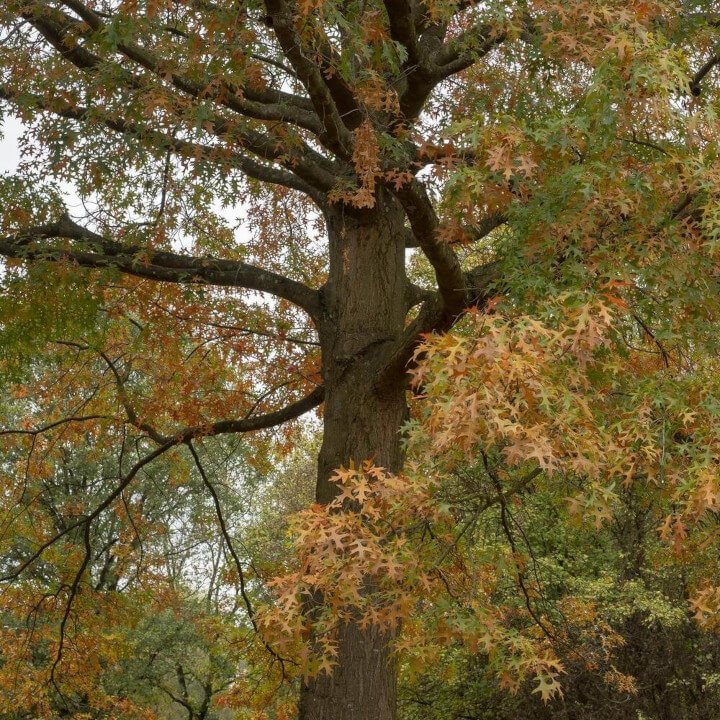Tree of the Month: Pin Oak
Quercus Palustris
While the pin oak might seem like an average oak tree, it’s a great option for Nashville’s urban canopy, particularly because it’s native to Tennessee’s mild-to-warm and slightly humid climate. That preference is reflected in its scientific name, Quercus (oak) palustris (swamp or marsh), and its other common name, the swamp oak. This deciduous tree likes moist soils that are slightly acidic, which makes it a robust city tree since it can tolerate some pollution. Its unique leaves, fast growth rate, and native status make the pin oak tree an excellent landscaping choice for almost any Nashville yard.
What Do Pin Oak Trees Look Like?
Pin oaks have distinctive leaves that maintain the signature five to nine lobes that many oak leaves display, but pin oak leaves are long and pointed rather than rounded. Another main difference is that the sturdy, dark green leaves are slightly smaller than other types of oaks. In the fall, their leaves turn to red, orange, and brown, and like the related American beech tree, a pin oak tends to hold on to its leaves over winter before dropping them in early spring when new buds form on the branches. A deciduous tree that holds onto its leaves over winter is said to be marcescent.
It's believed that the pin oak tree gets its name from the thin, pin-like branchlets that grow on the tree’s lower trunk. The tree’s branches in general tend to be thinner than other oaks, and they arch outwards, with lower branches reaching straight out or bending down, while upper branches reach up, forming a pyramid shape as the tree grows.
The bark of a pin oak develops thin ridges over time, but they don’t get very deep. Since these moisture-loving trees do best in lowlands and valleys, they tend to develop slight buttresses at the bottom of the trunk, like other wetland trees, that help stabilize the tree in shallow or flooded ground.
True to its other common name, the swamp oak does best in loamy or clay soils that retain moisture and remain slightly acidic. As such, they aren’t well suited to highland locations, which drain and dry out too quickly for their comfort (but you won’t actually find a pin oak in a swamp, which would be too wet for this species). However, these trees do prefer to be in the open sun and aren’t the most shade-tolerant tree. They grow up to 75 feet, sometimes taller, and when they have room to spread, they open into a wide crown that offers a generous amount of shade.
Pin Oaks and Wildlife
Like other oaks, the pin oak tree produces cup-shaped acorns that mature every other year. Pin oak tree acorns are an important food source for a variety of wildlife, which is one of the reasons it’s an important tree for the wider canopy’s local ecosystem. The acorns provide food for a wide range of animals like deer, squirrels, and mice, as well as woodland birds and waterfowl such as woodpeckers, blue jays, wild turkeys, and ducks. In addition, the big, leafy canopies give shelter to squirrels, birds, and insects of all kinds.
Is the Pin Oak a Desirable Tree?
The pin oak is a fast-growing tree that offers substantial shade and lots of wildlife habitat, with sturdy roots that help keep it firmly in place. Even though this tree prefers moist conditions, it’s relatively heat tolerant, which is another reason it’s a good choice for a sunny residential or downtown location. Since the branches of a pin oak don’t grow straight out, but rather arch upwards or downwards, it can be planted in spaces that a wider tree couldn’t, giving some flexibility for smaller yards or as part of a diverse landscaping strategy.
The pin oak’s hardy nature, coupled with some of its more general characteristics, make this a resilient landscaping tree for towns and cities. As a tree that’s native to the eastern and midwestern US, a pin oak adds many valuable benefits to a neighborhood canopy ecosystem.
If you’re convinced, check out the pin oak’s listing in our tree sale, where you can purchase native saplings for your own home’s canopy. For those who don’t own their homes but want to get involved in supporting Nashville’s canopy, consider volunteering with us! In any case, sign up for our newsletter to stay informed on tree news and information that will help you stay aware of the canopy around us!

